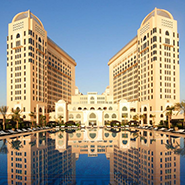- About
- Subscribe Now
- New York,
September 22, 2015

Luxury hotel brands have made strides in employing guided selling tactics but still have lots of room to improve, according to a new report by L2.
Filters and sorting options that allow consumers to search rooms by criteria, interactive features such as guided tours and room comparisons and user content are examples of guided selling that could make the booking process easier. With a wider variety of options at their fingertips than ever before, it is important that hotels make searching and booking a breeze for consumers to avoid losing out to competition with a better interface.
L2’s “Insight Report: Luxury Hotels Guided Selling" compiles the results of a study showing the investments hotels have made in guided selling tactics in 2015 compared to the prior year. Although there have been improvements, many expected features are still lacking from a surprisingly large percentage of brands.
Late risers
Flexible date calendars, which allow users to adjust check-in and check-out dates quickly and easily after selecting a property, are only provided by half of the brands that were studied, and most did not overlay prices on top of dates, meaning users would have to select the date and wait for the new date to load to compare prices.
Ritz-Carlton "offers" page
In what seems like another intuitive feature, despite usually offering an option to display special offers and promotions, hotels do not always allow users to filter those offers by the dates they are available, requiring consumers to sift through all of the offers and look out for those that fit their dates.
However, almost all of those that do allow users to display offers allow filtering by location, and just shy of three-quarters allow filter by interest as well.
Interactive features are less common. Only 26 of 50 hotels studied for their use of interactive tools use an interactive map highlighting the hotel, which would allow viewers to easily discern the hotel’s location in relation to various points of interest. While half allow for a virtual tour of the property, only one-sixth allow for direct room comparison, the lack of which would require users to navigate two different tabs in their browser to compare.
The Peninsula Hotels offers easy room comparison
In each category, there are exceptional hotels that make navigation or use easier for consumers.
Four Seasons, for example, uses a series of dropdown menus to allow users to filter results in a number of different ways. Joie de Vivre Hotels, meanwhile, goes above and beyond with interactive service, asking users questions in a quiz that will return a list of recommended results, interactive maps and options to further narrow results.
But, these are the standouts rather the norm – in general, hotels fail to provide users with a full array of options that could help them overcome option paralysis.
Four Seasons "interest" filter
As of March 2015, two-thirds of hotels feature reviews, an increase from 59 percent the previous May but still small considering the highly effective model of TripAdvisor, which relies entirely on user reviews to determine the best places to stay.
On mobile sites, the number stands at 38 percent, 7 percent higher than in May 2014, but barely half the number that display reviews on desktop. As mobile Web use continues to overtake desktop Web use, brands must ensure that they have the best possible version of their site accessible from the relatively new platform.
Recently, hotels have taken initiatives to showcase brand values to maximize their role in experiential travel and demonstrate social awareness by engaging in philanthropic causes or offering special events and culinary options for guests. L2’s study shows that a different way a hotel may gain an edge on its competition is by upgrading its Web site.
Digital future
Despite lagging behind when it comes to booking options, hotels have proven they can take advantage of the modern consumers' wants and needs to deliver a great experience.
Last month an L2 report found that nearly 100 percent of luxury hospitality brands offer guests an “in-stay” mobile application for Apple iPhones.
Luxury hospitality brands may have been slow to adapt mobile touchpoints but recently hoteliers are upping their mobile offerings through standard booking apps to keyless entry using Apple Watch to maintain modernity in an increasingly mobile-optimized landscape. L2’s “Luxury Hotels In-Stay” Insights Report examines how these “low-touch luxury” touchpoints have reconfigured a traditional stay in a high-end hotel property by creating guest convenience, accessibility and independence all through mobile technologies (see story).
It is just as important for other sectors to take advantage of new technology to maximize reach and attract consumers.
A July 2015 report by Frost & Sullivan concluded that multichannel retailing is the future of the automotive industry, with 50 to 60 percent of sales leads expected to come through digital means by 2016, compared to 15 percent in 2014.
New store formats, such as digital showrooms and pop-ups, offer original equipment manufacturers (OEMs) a cost-effective way to reach consumers and generate sales, but this change in retail strategy requires investment from brands. As automakers alter the way in which consumers interact with their brand during the purchase path and post-purchase, the challenge will be to retain a sense of consistency and loyalty (see story).
Final Take
Forrest Cardamenis, editorial assistant on Luxury Daily, New York
Share your thoughts. Click here